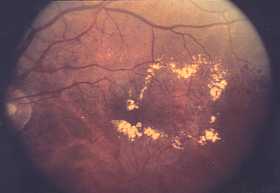Diabetic Macular Edema (DME) is a serious eye condition that affects individuals with diabetes. It occurs when damaged blood vessels in the retina leak fluid into the macula—the central part of the retina responsible for sharp, straight-ahead vision—leading to swelling and distorted vision. The white areas in the picture are components of the blood that have leaked out of the weak vessel walls. If left untreated, DME can result in significant vision loss and even blindness.
Symptoms of Diabetic Macular Edema
Individuals with DME may experience:
- Blurry or wavy central vision
- Colors appearing washed out
- Floaters
- Double vision
These symptoms can progress gradually, making regular eye examinations crucial for early detection and management.
Risk Factors
DME is more likely to develop in individuals who have:
- Prolonged duration of diabetes
- Poor blood sugar control
- Hypertension (high blood pressure)
- Hyperlipidemia (high cholesterol levels)
- Fluid retention
- Hypoalbuminemia (low levels of albumin in the blood)
Managing these conditions can help reduce the risk of developing DME.
Advancements in Treatment
Recent years have seen significant progress in DME treatment options, including multiple ways to lower VEGF levels:
-
Anti-VEGF Injections: Medications such as aflibercept, ranibizumab, and the newer faricimab are injected into the eye to inhibit vascular endothelial growth factor (VEGF), reducing fluid leakage and swelling. Faricimab, approved in 2022, targets both VEGF and angiopoietin-2, offering potential for extended treatment intervals.
-
Steroid Implants: Corticosteroid implants can reduce inflammation and edema in patients who do not respond adequately to anti-VEGF therapy.
-
Laser Photocoagulation: While less common due to advancements in pharmacologic treatments, laser therapy can still seal leaking blood vessels in some instances.
-
Emerging Therapies: Research into noninvasive treatments, such as medicated eye drops and the application of artificial intelligence to monitor disease progression, is ongoing and shows promise for future management strategies.
-
Nutritional Supplements: Fish oil (rich in omega-3 fatty acids) and rutin (a natural bioflavonoid) may serve as complementary therapies. Omega-3s offer anti-inflammatory and anti-angiogenic benefits, while rutin may help stabilize blood vessels and reduce VEGF activity.
Preventive Measures
To minimize the risk of developing DME:
-
Maintain Optimal Blood Sugar Levels: Tight glycemic control is essential in preventing or slowing the progression of diabetic retinopathy and DME.
-
Regular Eye Examinations: Annual comprehensive dilated eye exams can detect early signs of retinal changes before significant vision loss occurs.
-
Manage Blood Pressure and Cholesterol: Controlling hypertension and hyperlipidemia reduces the stress on retinal blood vessels, decreasing the likelihood of leakage.
-
Adopt a Healthy Diet: Some studies suggest that dietary changes, such as adopting a ketogenic diet, may have positive effects on diabetic complications, including DME. Incorporating omega-3 rich foods (like fish oil) and bioflavonoids (like rutin) may provide additional protection against eye damage.
-
Monitoring Tools: Patients are encouraged to use tools like the Amsler grid at home to monitor changes in their central vision. Any new distortions or blurriness should prompt immediate consultation with an eye care professional.
Monitoring Tools
Patients are encouraged to use tools like the Amsler grid at home to monitor for changes in their central vision. Any new distortions or blurriness should prompt immediate consultation with an eye care professional.
Explore More on Eye Complications
This article is part of a series covering different eye complications, their development, and what can be done to prevent or treat them. Click the links below to learn more:
- Protecting Your Vision: Understanding Diabetes and Eye Complications
- How Diabetes Affects Your Vision: Early Changes and What to Expect
- Background Diabetic Retinopathy
- Preproliferative Diabetic Retinopathy (PPDR): Causes, Symptoms, and Management
- Understanding Proliferative Retinopathy
- Diabetic Macular Edema
- Cataracts and Diabetes
- Why Eye Damage Happens

